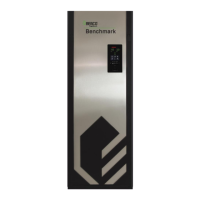Benchmark Platinum-Edge [II]: Operation-Service Manual
SECTION 5 – SAFETY DEVICE TESTING
OMM-0137_E • GF-211 • 12/13/2019 Technical Support • (800) 526-0288 • Mon-Fri, 8 am - 5 pm EST Page 62 of 153
5.3 HIGH GAS PRESSURE TEST
Complete the instructions in Section 5.3.1 for BMK750 – 2500 units, or in Section 5.3.2 for
BMK3000 – 6000 units, which have different High Gas Pressure switches.
5.3.1 HIGH GAS PRESSURE TEST: BMK750 – 2500
To simulate a high gas pressure fault, refer to Figure 5-3a through Figure 5-3c and perform the
following steps:
HIGH Gas Pressure Test Instructions: BMK750 – 2500
1. Close the leak detection ball valve located at the High Gas Pressure switch.
2. Remove the 1/4" NPT plug from the High Gas pressure leak detection ball valve shown in
Figures 5-3a through 5-3c.
3. Install a 0 - 16” W.C. (0 – 4.0 kPa) manometer or gauge where the 1/4" plug was removed.
4. Slowly open the leak detection ball valve.
5. On the Controller, go to: Main Menu → Diagnostics → Manual Run.
6. Enable the Manual Mode control.
7. Set the valve position between 25% and 30% using the + (Plus) and – (Minus) controls.
8. With the unit running, monitor the gas pressure on the manometer installed in step 2 and
record the gas pressure reading.
9. Slowly increase the gas pressure using the adjustment screw on the SSOV while
counting the number of turns you make.
10. The FAULT indicator should start flashing and the unit should shut down and display a
Fault Lockout - Gas Pressure Fault message at approximately the value shown in Table
5-2 (the pressure setting of the High Gas Pressure switch). If the unit does not trip off
within 0.2” W.C. of the pressure shown, the switch needs to be replaced.
TABLE 5-2: HIGH Gas Pressure, ± 0.2” W.C. (± 50 Pa)
BMK750/1000 FM & DBB Single-Fuel
BMK1500/2000 DBB Single-Fuel
BMK1500/2000 DBB Dual-Fuel
BMK2500 FM & DBB Single-Fuel
11. Reduce the gas pressure by returning the SSOV adjustment screw back to its original
position before starting step 9 (the value recorded in step 8). This pressure should be
within the range used during combustion calibration, shown in Table 4-1 (Natural Gas) and
Table 4-4 (Propane gas).
12. Press the CLEAR button on the Edge Controller to clear the fault.
13. The fault message should clear, the FAULT indicator should go off and the unit should
restart (if in Manual mode).

